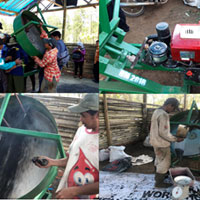Go Organic-Gerakan Kelompok Petani Pesanggem Dalam Biokonversi Kulit Kopi Menjadi Kompos dan Pupuk Organik Granule
DOI:
https://doi.org/10.14421/jbs.1400Keywords:
Kompos, kualitas kompos, pupuk organik granul, residu kulit buah kopi, teknologi pupuk organikAbstract
Sejak tahun 2016, Universitas Brawijaya memperoleh mandat dari Kementerian Lingkungan Hidup dan Kehutanan untuk mengelola hutan seluas 544 ha di lereng Gunung Arjuno menjadi hutan Pendidikan dan Pelatihan, yang diberi nama UB Forest. Di dalam UB forest terdapat petani penggarap yang menanam kopi dibawah tegakan pinus. Setiap tahun, produksi kopi di UB Forest mencapai 600 kg ha-1, dengan potensi limbah sisa panen kulit kopi antara 50–60%. Limbah sisa panen kulit kopi tersebut hanya ditumpuk saja dan berpotensi menimbulkan pencemaran. Kegiatan ini ditujukan untuk meningkatkan pengetahuan dan keterampilan kelompok tani hutan UB Forest di dalam mengolah sisa panen kulit kopi menjadi pupuk kompos dan pupuk organik granul (POG). Kegiatan yang dilakukan meliputi: 1) Penyuluhan; 2) Pembuatan rumah produksi kompos; 3) Introduksi mesin granulator; 4) Pelatihan pembuatan kompos dan POG; 5) Pengemasan produk, dan 6) analisa kualitas kompos dari kulit kopi. Hasil kegiatan meliputi 1) tersedianya rumah produksi pupuk organik granul beserta alat pembuat pupuk organik granule (granulator); 2) 85% dari petani hutan peserta penyuluhan dan pelatihan mengalami peningkatan pengetahuan dan keterampilan di dalam mengolah sisa panen kulit kopi menjadi kompos dan pupuk organik granul; 3) kelompok tani hutan memiliki modul dan SOP pembuatan kompos dan pupuk organik granul.
[Since 2016, Brawijaya University received a mandate from the Indonesian Ministry of Environment and Forestry to manage 544 hectares (ha) of forest, located in the slopes of Mount Arjuno, as a forest for Education and Training, which is named UB Forest. In UB forest, there are forest farmer who planted coffee under the pine trees. Every year, coffee production in UB Forest reaches 600 kg ha-1, with 50-60% of them is coffee peel. The waste of the remaining coffee peel is only stacked and potentially cause pollution. This activity is aimed to increase the knowledge and skills of forest farmer groups (UB Forest) in processing the remaining coffee peel into compost and granular organic fertilizer (POG). The activities included: 1) Counseling; 2) Creating compost production houses; 3) Introducing of granulator machines; 4) Training in composting and POG; 5) Product packaging, and 6) analysis of the quality of compost. The results of the activities included: 1) the availability of houses for the production of compost and POG along with the tools for processing granule organic fertilizers (granulators); 2) 85% of forest farmers participating in counseling and training experience increased knowledge and skills in processing the remaining coffee peel into compost and granule organic fertilizer; 3) forest farmer groups have modules and SOPs for composting and granule organic fertilizer.]
References
Azizah, N., Kurniawan, S., Fajriani, S. 2011. Application of granule enriched compost on onion (Allium cepa). Prociding National Conference of Hortikultura 2011.
Azizah, N., Prasetya, B., Kurniawan, S. 2013. Enriched-granular compost (EGC) from campus organic waste as soil conditioner in intensive rice farming system. J.Agrivita. 35(2): 184 - 192
Badan Standardisasi Nasional (BSN). 2004. SNI 19-7030-2004. Compost specification from local organic waste (Spesifikasi kompos dari sampah organik domestik).
Keputusan Menteri Pertanian Nomor 261/KPTS/SR.310/M/4/2019. Persyaratan teknis minimal pupuk organic, pupuk hayati, dan pembenah tanah. Kementerian Pertanian, Jakarta.
Kurniawan, S., Utami, S.R., Agustina, C., dan Lestari, N.D. 2017. Pengaruh tutupan lahan dan pengelolaan tanah di UB Forest terhadap perubahan sifat biokimia tanah. Laporan penelitian BOPTN Fakultas Pertanian – Universitas Brawijaya.
Ramli, Zulfita, D., dan Safwan, M. 2014. The influence of coffee fruit peel compost on the growth and yield of Petsai in Alluvial soil (Pengaruh kompos kulit buah kopi terhadap pertumbuhan dan hasil tanaman petsai pada tanah aluvial). Jurnal sains mahasiswa pertanian, Vol. 3 No 1.
Valentiah, F.V., Listyarini, E., Prijono, S. 2015. Application of coffee fruit peel compost to improve soil chemical and physical properties in Inceptisol and increasing boccoli yield (Aplikasi kompos kulit kopi untuk perbaikan sifat kimia dan fisika tanah Inceptisol serta meningkatkan produksi brokoli). Jurnal Tanah dan Sumberdaya Lahan. Vol. 2, No. 1

Downloads
Published
How to Cite
Issue
Section
License
Authors who publish with this journal agree to the following terms:
- Authors retain copyright and grant the journal right of first publication with the work simultaneously licensed under a Creative Commons Attribution-NonCommercial-ShareAlike 4.0 International (CC BY-NC-SA 4.0) that allows others to share the work with an acknowledgement of the work's authorship and initial publication in this journal.
- Authors are able to enter into separate, additional contractual arrangements for the non-exclusive distribution of the journal's published version of the work (e.g., post it to an institutional repository or publish it in a book), with an acknowledgement of its initial publication in this journal.
- Authors are permitted and encouraged to post their work online (e.g., in institutional repositories or on their website) prior to and during the submission process, as it can lead to productive exchanges, as well as earlier and greater citation of published work.





